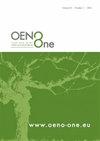Wine acidification methods: a review
IF 2.2
3区 农林科学
Q3 FOOD SCIENCE & TECHNOLOGY
引用次数: 1
Abstract
Global warming is directly linked to a lower concentration in organic acids in grape berries, leading to higher pHs in wine. Because of this lack of acidity, many important factors are impacted, as wine acidity and pH play a crucial role in various equilibriums. Indeed, the lower acidity and the higher pH modify the parameters of wine, such as free and molecular sulfur dioxide availability, colour and sensory aspects. Therefore, it is an ongoing challenge for winemakers to deal with wine acidification and thus preserve wine physico-chemical properties and prevent early spoilage due to microbiological instability induced by high pH. Different acidification methods are allowed by the OIV, chemical acidification being one the most common, followed by physical acidification and microbiological acidification. This review examines these three methods of acidification. The first part details chemical acidification and gives a complete description of various organic acids used in winemaking, and their different properties and regulations; the second part focuses on physical acidification, such as cation exchange resins and electrodialysis; and the last part briefly reviews the novelty of microbiological acidification in wine.葡萄酒酸化方法综述
全球变暖与葡萄浆果中有机酸浓度降低直接相关,从而导致葡萄酒的pH值升高。由于酸度不足,许多重要因素都会受到影响,因为葡萄酒的酸度和pH在各种平衡中起着至关重要的作用。事实上,较低的酸度和较高的pH值改变了葡萄酒的参数,如游离和分子二氧化硫的可用性、颜色和感官方面。因此,酿酒师面临的一个持续挑战是处理葡萄酒酸化,从而保持葡萄酒的物理化学特性,防止由于高pH引起的微生物不稳定性而导致的早期腐败。OIV允许不同的酸化方法,化学酸化是最常见的酸化方法之一,其次是物理酸化和微生物酸化。这篇综述考察了这三种酸化方法。第一部分详细介绍了化学酸化,并对酿酒中使用的各种有机酸及其不同的性质和规律进行了完整的描述;第二部分着重介绍了物理酸化,如阳离子交换树脂和电渗析;最后简要评述了葡萄酒中微生物酸化的新颖性。
本文章由计算机程序翻译,如有差异,请以英文原文为准。
求助全文
约1分钟内获得全文
求助全文
来源期刊

OENO One
Agricultural and Biological Sciences-Food Science
CiteScore
4.40
自引率
13.80%
发文量
85
审稿时长
13 weeks
期刊介绍:
OENO One is a peer-reviewed journal that publishes original research, reviews, mini-reviews, short communications, perspectives and spotlights in the areas of viticulture, grapevine physiology, genomics and genetics, oenology, winemaking technology and processes, wine chemistry and quality, analytical chemistry, microbiology, sensory and consumer sciences, safety and health. OENO One belongs to the International Viticulture and Enology Society - IVES, an academic association dedicated to viticulture and enology.
 求助内容:
求助内容: 应助结果提醒方式:
应助结果提醒方式:


